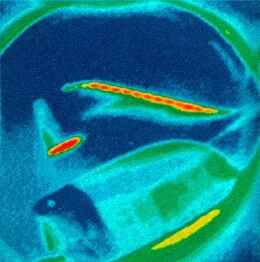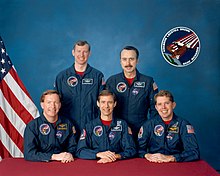
Back STS-28 Arabic STS-28 Bulgarian STS-28 Czech STS-28 Danish STS-28 German استیاس-۲۸ Persian STS-28 French STS-28 Galician STS-28 HE STS–28 Hungarian
 Infrared view of Columbia's left wing during reentry, photographed by the SILTS experiment. | |
| Names | Space Transportation System-28 STS-28R |
|---|---|
| Mission type | DoD satellites deployment |
| Operator | NASA |
| COSPAR ID | 1989-061A |
| SATCAT no. | 20164 |
| Mission duration | 5 days, 1 hour, 8 seconds |
| Distance travelled | 3,400,000 km (2,100,000 mi) |
| Orbits completed | 81 |
| Spacecraft properties | |
| Spacecraft | Space Shuttle Columbia |
| Landing mass | 90,816 kg (200,215 lb) |
| Payload mass | 19,600 kg (43,200 lb) |
| Crew | |
| Crew size | 5 |
| Members | |
| Start of mission | |
| Launch date | August 8, 1989, 12:37:00 UTC (8:37 am EDT) |
| Launch site | Kennedy, LC-39B |
| Contractor | Rockwell International |
| End of mission | |
| Landing date | August 13, 1989, 13:37:08 UTC (6:37:08 am PDT) |
| Landing site | Edwards, Runway 17 |
| Orbital parameters | |
| Reference system | Geocentric orbit |
| Regime | Low Earth orbit |
| Perigee altitude | 289 km (180 mi) |
| Apogee altitude | 306 km (190 mi) |
| Inclination | 57.00° |
| Period | 90.50 minutes |
| Instruments | |
| |
 STS-28 mission patch  Standing: Brown and Adamson Seated: Richards, Shaw and Leestma | |
STS-28 was the 30th NASA Space Shuttle mission, the fourth shuttle mission dedicated to United States Department of Defense (DoD) purposes, and the eighth flight of Space Shuttle Columbia. The mission launched on August 8, 1989, and traveled 3,400,000 km (2,100,000 mi) during 81 orbits of the Earth, before landing on runway 17 of Edwards Air Force Base, California, on August 13, 1989. STS-28 was also Columbia's first flight since January 1986, when it had flown STS-61-C, the mission directly preceding the Challenger disaster of STS-51-L. The mission details of STS-28 are classified, but the payload is widely believed to have been the first SDS-2 relay communications satellite. The altitude of the mission was between 295 km (183 mi) and 307 km (191 mi).[1]
The mission was officially designated STS-28R as the original STS-28 designator belonged to STS-51-J, the 21st Space Shuttle mission. Official documentation for that mission contained the designator STS-28 throughout. As STS-51-L was designated STS-33, future flights with the STS-26 through STS-33 designators would require the R in their documentation to avoid conflicts in tracking data from one mission to another.
- ^ "STS-28 payload". Archived from the original on February 4, 2015. Retrieved February 3, 2015.